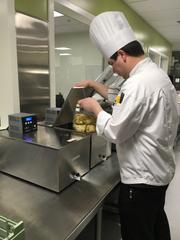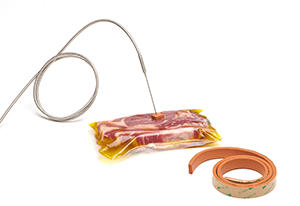Does vacuum sealing and/or pasteurization with sous vide cooking really allow you to get days or weeks ahead in food preparation?
The answer is yes, but careful consideration must be given to refrigeration procedures and storage temperatures.

Foods that have been cooked should be cooled before being refrigerated.
The reason for this is that placing a heat load inside your refrigerator will raise the temperature of the surrounding food and cause the equipment to work harder than necessary.
Another reason for rapidly cooling food is that some bacteria are able to enter a dormant state by forming surrounding spores with thick cell walls that protect them.
The bacterium of most concern in this case is C. Botulinum.
These spores are damaged during cooking, but have the ability to regenerate.
C. botulinum spores need to reach 250° F (121° C) to die, as happens in the canning process.
If the food is cooled slowly, this environment becomes favorable for the spores to regenerate, activate, grow and multiply.
Rapid cooling and cold storage greatly slow down this regeneration.
Gradual cooling is a process of gently cooling foods to optimize juiciness, flavor and texture.
The other advantage is that partial cooling of food before entering an ice bath is that, since much of the heat load has already been removed, the ice bath can cool the product more effectively.

After removing the food from the Sous Vide bath, place the bags horizontally on a cooling rack to allow air circulation around the product.
Let the bags rest for 10-15 minutes, depending on size.
After air cooling, fill a sink with the coldest water that comes out of the faucet.
Let the bags stand in the cold water for 10-15 minutes, depending on the size.
To avoid problems, gently shake the bags by hand in the middle of the cooling process.
This will dissipate any hot spots that have developed.
After cooling in cold water, transfer the bags to a container with a 50/50 mixture of ice and water.
Cool the product in the ice bath for 2 hours or until the product reaches a temperature of 41° F (5° C) as tested by a core temperature probe (measured at the thickest point of the product).
Replenish ice as needed to maintain a 50/50 ratio during cooling.
To avoid problems, gently shake the bags by hand in the middle of the cooling process.
This will dissipate any hot spots that have developed.

A strong and consistent cold chain is a critical defense to curb the growth of potentially harmful bacteria.
Many countries have their own restrictions on storage temperatures and shelf life for sous vide and vacuum packaging and storage.
Consult your local laws for specific information on this topic.
Sometimes, different states or municipalities continue to adopt older regulations (depending on the food code they follow).
– According to the 2017 Food Code: foods Sous Vide kept at 41° F (5° C) or below may be kept for no more than 7 days, at which time the food should be consumed, discarded or kept frozen with no shelf-life restriction while frozen until consumption or use.
– Store cooked food for 30 days (from date of packaging) at 34° F (1° C) or less.
Note that this is colder than most standard refrigerators.
If you cannot adjust the temperature of your refrigerator to meet this requirement, try wrapping the food in ice or an ice bath to reach this temperature.
– Once food has been removed from a 34° F (1° C) storage environment, keep food at 41° F (5° C) or less for up to 72 hours.
– Hold food for up to 72 hours at 38° F (3° C) or less if not previously cooled and held at 34° F (1° C).
– There is no restriction on the shelf life of frozen foods.

TÖUFOOD is a complete line of products of exceptional quality, developed by GASTROCULTURA MEDITERRÁNEA SL, which allows the most well-known techniques of modern cuisine to be put into practice. Innovative recipes can be easily realised, bringing excitement and surprise to dishes, offering a stimulating and memorable culinary experience.